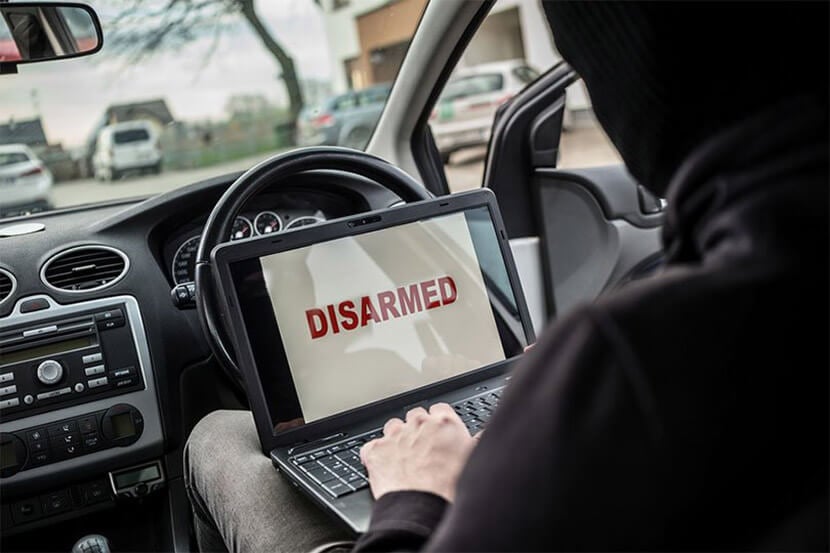When we're talking about cutting the cost of car insurance, a tip that always comes up is ‘make sure you improve your car security with an immobiliser and alarm’. It's one of the most common ways to keep your car secure from thieves.
But what is an immobiliser, how can you make sure you have one and what are the best alarms and trackers for the job? Here’s what you need to know.

What is a car immobiliser?
A car immobiliser is a device that only allows your car to start if you’re using the correct key or fob. This means your car is protected against hot-wiring from would-be thieves.
When you get in your car, the key or fob sends an electronic code that allows your vehicle to start. This means if a thief tries to use an incorrect key, the car shouldn’t work. Typically, the car immobiliser disables 2 of 3 components:
- Fuel system
- Starter motor
- Ignition
A factory-fitted device is generally considered to be the best type of car immobiliser. That means it’s been installed by the manufacturers, so is more likely to function properly.
Factory-fitted immobilisers have been compulsory on all new vehicles in England and Wales since 1998. But if you’ve got an older car or buy a second-hand car, you could find your vehicle doesn’t have one.
Does my car have an immobiliser?
If your car was made after 1998, you should be safe in the knowledge that you’ve got a car immobiliser.
If your car is older than this, have a check. Some might've been fitted with an immobiliser at the factory and others might've had them installed later.
The easiest thing to do is check your owner’s handbook. Failing that, you can contact the manufacturer or ask a qualified mechanic to check for you.
Advantages of having a car immobiliser
The main advantage of having a car immobiliser is that it makes it much harder for a thief to hotwire it and drive it way.
This increase in security also means you might be able to get cheaper car insurance.
It's not a total security system though. Your car could still be towed away by thieves or broken into with your possessions stolen.
Can an immobiliser be defeated?
Having a car immobiliser certainly makes your car more secure, but it doesn’t prevent it being stolen altogether. Thieves could still tow away a car, for example.
And keyless car theft, where relay technology is used to steal vehicles, is on the rise.
To help improve your car's security, you could also:
-
Install a wheel lock
-
Add an alarm
-
Put your fob in a faraday pouch
What is a ghost immobiliser?
A ghost immobiliser is another type of device that you can fit discreetly to your car. It offers an additional layer of security.
In order to start the car, the driver has to input a PIN code that only they know. This should make it significantly more difficult for thieves to steal your car.
Only specific models of ghost immobilisers are approved by insurers. This is because most ghost immobilisers don’t comply with Thatcham’s categories for evaluation. Thatcham assesses the safety of vehicles and vehicle technology for insurers. This means a ghost immobiliser might not impact your car insurance premiums.
Some online resources suggest that The Autowatch Ghost Immobiliser is recognised by certain insurers, so it could be worth mentioning when you get a quote.
Common immobiliser problems
Faulty engine immobilisers are rare, but when it does happen it could cause car problems.
Typical issues include:
- Unlocking problems
- Locking problems
- Engine start problems
- Keys that don’t turn in the ignition
- Car alarm problems
If you’re having issues, the first thing to do is change the battery in your fob. If that doesn’t work, you should contact the dealer or garage where you bought the vehicle.
Other car alarms and trackers
If you want to keep your car safe, you might want an alarm and tracker on top of a car immobiliser. There are a few types to consider and some might come installed as standard when you get a new car.
These are the 3 main options:
Audible alarm systems
These are the alarms we typically think about that make a loud noise if someone tries to break into your car. If you buy a new vehicle, it’s likely that it has an audible alarm installed already.
The alarms are useful, as they might scare off any criminals. But one downside is people have a tendency to ignore them as they frequently go off accidentally.
Silent alarm systems
These alarms go off when someone tries to break into your car, but they don't make a sound. Instead, you're alerted as the owner. At that point, you could call the police and tell them your vehicle is being stolen.
You shouldn’t try and intervene on your own as it could be dangerous.
GPS tracking
Trackers won't stop your car being stolen, but they could help you get your vehicle back. Typically, they use GPS to show you where your car is in real time.
What is a Thatcham device?
Thatcham is an independent institution that rates car security and helps insurance companies factor this into their car insurance price calculations.
Thatcham has 7 different classes for car security. The closer to first class you get, the more robust your security is and the bigger the discount you could get on your car insurance.
Class 1 – electronic alarm and immobiliser
The most complex and secure system on the market. Class 1 alarms often run on their own battery supply and engine immobilisers have the ability to activate on their own. Both immobiliser and alarm have to be present for class 1.
Class 2 – electronic immobiliser
This is a class 1 car immobiliser but without the alarm. For class 2, it needs to be able to disable 2 of the 3 systems used to drive the car.
Class 2/1 – electronic alarm upgrade
If you have an immobiliser, you can add a class 1 alarm afterwards. Though this doesn’t push you into fully-fledged class 1 territory, it’s as close to it as you can get without getting a new car.
Class 3 – mechanical immobiliser
The most common kind of class 3 feature is a steering wheel lock. Class 3 features disable only 1 of the 3 systems used to drive a car. You need to fit these every time you want to secure the car.
Class 4 – wheel locks
If you’ve got a set of shiny alloys, you likely have wheel-locking nuts on them. These nuts can only be removed using a special key, making them harder to steal.
Class 5 – post-theft tracking
If your car is stolen, this system tracks its position so that the police can recover it. They also have the ability to immobilise the car remotely.
Class 6 – tracker
This is a class 5 tracker but without the ability to remotely immobilise the car.
Class 7 – tracker
A more simplistic version of a class 6 tracker that allows police to recover a stolen car.
There’s also a Q class that covers aftermarket security upgrades that don’t fall into classes 1-7. This includes locks and alarms that aren’t approved by Thatcham.
Does my car have a Thatcham alarm?
Almost all new cars in the UK are fitted with a Thatcham category 1 alarm. But if your car is older, or second hand, it might not.
To find out for certain, you need to check your car owner's manual or directly with the manufacturers.
If you’re adding an alarm to your car, get one that’s Thatcham approved at the highest level to help drive down your car insurance costs.
How do alarms, trackers and immobilisers impact my car insurance policy?
The higher the level of security you have, the more difficult your car is to steal. This should mean you pay less for your car insurance.
Making sure you have a Thatcham-approved alarm and car immobiliser could have a significant impact on your insurance costs. If your car doesn’t come with these, you could install them.
Check with your individual insurer to find out if it will reduce the cost of your car insurance.
Some insurers may specify that as part of a policy you need to have a tracker installed in your car. Failure to do this could make your policy invalid. Before getting a policy, it's worth checking the policy details to see if you do need to have one installed.
If you want to enhance your security even more, consider keeping your car in a garage overnight. You can also take a look at our tips on cutting the cost of car insurance.

